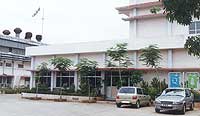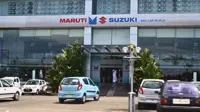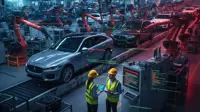The Deming dash
By Venkatachari Jagannath | 23 Dec 2003
 Chennai: It was literally a dash for the prestigious medal for the 46-year-old S Sundar Ram, president, Rane Brake Linings. Only in December 1999 did the company decide to have a crack at the Deming Award and duly aligned its production process.
Chennai: It was literally a dash for the prestigious medal for the 46-year-old S Sundar Ram, president, Rane Brake Linings. Only in December 1999 did the company decide to have a crack at the Deming Award and duly aligned its production process.
October 2003 saw Rane Brake Linings reaching the final post — in the shortest span of time. The company is part of the city-based Rs 687-crore Rane group, which manufactures auto components like steering and suspension systems, seat belts, valves, valve guide and tappets.
"We were not pressured by Sundaram Brake Linings or other TVS group companies winning the award. It is just that we wanted to go forward," says Ram. An IIT Madras BTech graduate, Ram also has a management degree from IIM Calcutta.
An ISO 9001 and 14001 company, Rane Brake Linings has one each in Chennai, Hyderabad and Pondicherry, manufacturing asbestos and asbestos-free brake linings, clutch facings, disc pads and railway brake blocks. The company has a technical collaboration with Nisshinbo Industries, Japan, and employs 827 people.
"Last year we registered a turnover of Rs 122 crore and a net profit of Rs 19.5 crore. We are No 1 in the original equipment manufacturers (OEM), replacement and the railways market in India," says Ram.
 Nevertheless, Rane Brake Linings unlike its major competitor Sundaram Brake Linings, is not a major exporter. The Deming tag is supposed to come handy for the company while tackling the export market anew. He talks in detail about the company's dash towards Deming. Excerpts:
Nevertheless, Rane Brake Linings unlike its major competitor Sundaram Brake Linings, is not a major exporter. The Deming tag is supposed to come handy for the company while tackling the export market anew. He talks in detail about the company's dash towards Deming. Excerpts:
When did you plan to go for the Deming Award? What prompted you?
With increasing globalisation of the Indian economy, slowly but surely the quality standards in the Indian market were improving progressively. For an Indian manufacturer to be successful in such an environment this calls for world-class standards of product and processes. In this context we felt a need to launch an initiative with clear milestones, so that the whole organisation could work towards world-class standards. TQM [total quality management] and the Deming Prize were the targets set for the organisation.
Although in the early days TQM was seen as a tool only to manage the quality of manufacturing processes, over the years it has expanded to cover almost every business processes. Today TQM addresses issues ranging from management of quality at the suppliers' end to the way the finished products are delivered to the customers. This is somewhat different from the concepts we are used to. TQM does not focus on the measurement of results; it focuses on the management of the processes and the measures used. The results are taken as guaranteed derivatives.
Although the TQM focus has been on operational excellence, in recent times it has taken yet another turn, whereby even the process of business strategy is included. Consequently, we believe TQM is a one-stop shop for management of business.
Could you describe the company before you started practising the quality parameters?
Earlier we were focusing only on production value and were suffering high level of plant rejections and customer returns. There were small individual kaizens — continuous improvement programmes. Statistical tools were used occasionally. There was no systematic initiative for improvements. Review and analysis were not carried out. The staff training programmes were need based and there was no structured training programme for operators. The concept of total employee involvement did not exist and employee involvement activities and analysis were not given importance. We were concentrating on meeting the requirements.
How did the process towards Deming start and how did it progress? Did you form a separate team for this purpose? If so what are the details about the team and its mandate? Did you engage any consultant for correcting this status?
At the group level an apex council was formed to review the progress and status of TQM implementations. At the company level, a steering committee was formed with all functional heads and plant heads as members. One senior management person was nominated as TQM — coordinator to propagate the learning's of Juse (Union of Japanese Scientists and Engineers) counsellors and also to review the implementation.
Further, all the group company CEOs reviewed the status of TQM implementation including group chairman L Lakshmanan and vice-chairman L Ganesh. We did engage leading Japanese consultants having hands on experience on the Deming Award and advanced problem solving techniques.
And then…
We established our TQM model placing the customer satisfaction at the top. The other processes can be broadly classified as follows:
- Defining the role of all the workers (role clarity)
- Development of new product development (NPD) system
- Setting up the review mechanism
- Process for strategy and strategy implementation
- Improvements in human resource practices
- Practice PDCA (plan, do, check, act) in all activities, systems, and processes.
What are the roadblocks you faced [mindset, factory layout, equipment used] and how were they sorted out?
The process of implementation calls for extreme rigour and therefore discipline on the part of the practitioners. While the western models look for short-term results, in the TQM model it requires deep and enduring involvement of people, and accountability is a major challenge. It took some time to change the culture and attitude of the people as they thought of the TQM processes as additional work. But when they realised that the quality process actually helped them the participation was excellent. The participation rate in the quality control circles zoomed to 66 per cent from 5.42 per cent in 1999 and the number of suggestions went up to 6,763 from 180 in 1999.
Did you make any additional investments for this?
No.
It takes some years for a company even to get the confidence of applying for the award. When did you achieve it and when did you apply for the award?
We got the confidence in June 2002 and we applied in December 2002.
What impact did the TQM practices have on your bottomline in terms of factory returns, customer returns, reduction in warranty claims, machine related scrap, raw material turnover, inventory turnover, work in progress, shift set-up time, productivity per employee, order book position, lead time to execute an order and other parameters? Could you give comparative figures — from what it was before the Deming process to what it is now?
The in-plant rejections came down to 1.07 per cent from 2.5 per cent. The customer line rejection which was 15,937 parts per million (ppm) in 1999 went down to 864 ppm this fiscal. The net sales per employee increased from Rs 8.87 lakh to Rs 12.76 lakh. The material yield improved by two per cent to 74 per cent. New product sales increased from Rs 10.84 crore to Rs 56.97 crore. The material price index has come down from100 to 95.4. Supplier raw materials rejections went down from 1.88 per cent to 0.70 per cent and the adherence to schedules is at 98 per cent.
Tell us about your labour relations and the wage structure. Is it comparable with the industry or better than that? And what is the number of days lost due to strikes during the past five years?
Our wage structure is better than the industry average. We have not lost any mandays due to strike during the last five years.
How did you involve your suppliers in this activity?
Our suppliers are involved in the design stage itself. We educate our suppliers on problem solving, ISO-related activities and the 5S — all Japanese terms: seiri (separating the required tools from the rest) seiton (neatly arranging tools and markings for easier identification) seiso (cleanup campaign) seiketsu (to conduct the above three regularly) and soitsuke (forming the habit of following the first four).
What does the new tag, 'A Deming Company', mean to your domestic as well as overseas markets? Will this result in increased sales?
TQM is an endless journey of continuous improvement in every aspect of business. The Deming Prize is only a milestone. The benefit will be the enhancement of customer confidence in us. This in turn will lead to greater business opportunities as we certainly look different in the customer eyes.
Your future plans…
The future business goals are to:
- Achieve net sales per employee in excess of Rs 25 lakh
- Bring down the customer returns to zero and in plant rejections to 0.3 per cent
- Increase export revenue to 15 per cent of the turnover; and
- Become a Rs 180-crore company by year 2007 and achieve a before-tax profit of 12 per cent on sales.






.webp)















